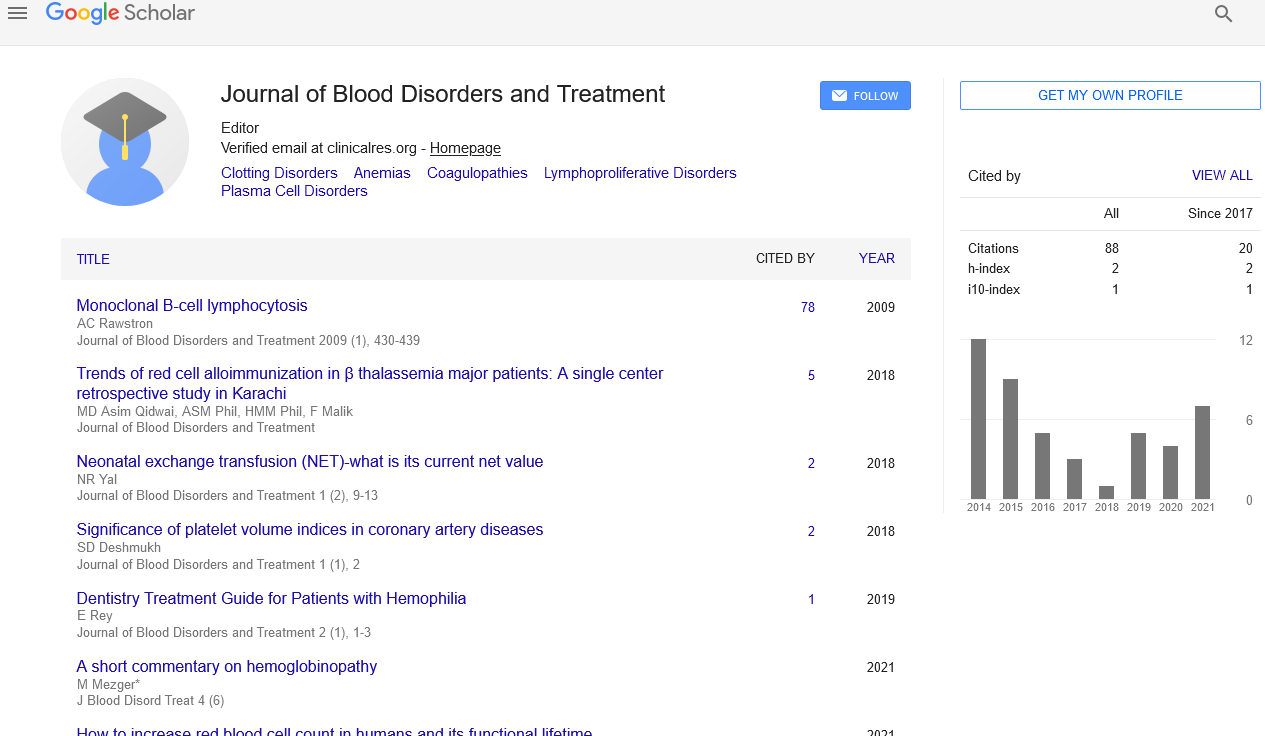Review on Myelodysplastic Syndrome
Received: 02-May-2021 Accepted Date: May 15, 2021; Published: 22-May-2021
This open-access article is distributed under the terms of the Creative Commons Attribution Non-Commercial License (CC BY-NC) (http://creativecommons.org/licenses/by-nc/4.0/), which permits reuse, distribution and reproduction of the article, provided that the original work is properly cited and the reuse is restricted to noncommercial purposes. For commercial reuse, contact reprints@pulsus.com
Abstract
Introduction
Myelodysplastic conditions (MDS) normally assigned as bone marrow (BM) disappointment are a heterogeneous gathering of myeloid clonal issues brought about by a disappointment of platelets development. The comorbidities result from a variable level of cytopenia and clonal flimsiness with an inclination to movement chiefly into intense myeloid leukemia (AML) however uncommon into intense lymphoblastic leukemia . MDS is uncommon under 40 years of age, as indicated by Surveillance, Epidemiology and End Reports (SEER), the assessed frequency increments with age with fivefold distinction in hazard between age 60 and ≥80 years. The occurrence rate is about 4.9 per 100,000 people/year in everyone. At all ages, it prevalently influences guys more than in females. The administration of MDS is viewed as one of the difficult issues confronting the hemato-oncologists as the aftereffects of numerous snags, for example, the high level age which is typically connected with non-hematological comorbidities make them generally narrow mindedness to treatment. Also, the cases advanced named auxiliary AML typically experience a lower reaction to standard of care treatment than the all over again cases. We pointed in this survey to sum up the fundamental idea in MDS the board and spotlight on the accessibility of the Food and Drug Administration (FDA)- affirmed specialists for certain clues on future heading [1]. The beginning phases of MDS, exorbitant modified cell demise (apoptosis) is the overwhelming occasion with resulting cytopenia with its variable degree and degree. chrysanthemi has a shorter life span than E.coli. Besides, with illness movement, quality change, and leukemic change, causing crushing of BM through the leukemic cells. Clonal change is the trigger for MDS improvement prompting typical undeveloped cell concealment. This transformation may result from hereditary powerlessness or harm of hematopoietic undeveloped cells. Most patients with MDS have no clear reason (roughly 80%) and named as idiopathic or essential. Optional MDS as indicated by The World Health Organization (WHO) creates a long time after openness to referred to specialists causing chromosomal harm like chemotherapy (alkylating specialists, topoisomerase II inhibitors), radiotherapy, substantial metals (mercury, lead), viral disease, poisonous synthetics (benzene, fungicide), and some immune system conditions [2].
Post alkylating specialists like Nitrogen mustards, portrayed by late beginning around 5-7 years after openness with explicit karyotyping (- 5, del(5q), - 7, del(q) and complex). While in the event of post topoisomerase II inhibitors, for example, anthracycline/etoposide, portrayed by beginning stage 1-3 years with chromosomal anomalies (MLL quality ). Although hereditary inclination is uncommon, familial occurrences are accounted for. Familial platelet issue is the best model described by a transformation in RUNX1 and GATA2 inclining to MDS.
Familial AML with changed CEBPA and telomere science issues are another types of familial MDS might be identified during relatives evaluating for BM transplantation.Two-hit model of movement from constant MDS into AML may help in understanding the essential of leukemic change. It might incorporate atomic and cytogenetic variations either in first or second hit class transformations during the illness movement. As a matter of fact, the systems of leukemic change are not unmistakably perceived There is no particular history in regards to MDS analysis with the exception of which identified with BM disappointment in type of ecchymoses, petechiae, and seeping from nose and gum are the overall appearances of thrombocytopenia Fever, repetitive disease, and up to stun might be a sign of neutropenia. Disquietude, weariness, and exasperating heart infection may result from weakness. An International Consensus Working Group prescribed in any event 2 models to analyze MDS: stable cytopenia for a half year or 2 months just when was related with explicit cytogenetic or bi-genealogy dysplasia, also, different reasons for dysplasia and cytopenia ought to be rejected. MDS is a heterogeneous sickness, the impacts check isn't the just deciding component in therapy choice. In view of scoring frameworks, we should place the patient in a low or high-hazard bunch class. Generally safe incorporates IPSS low, middle; IPSS-R or WPSS, exceptionally low, low or moderate. High danger incorporates IPSS halfway 2, high; IPSS-R middle, high, high; WPSS high, extremely high [3].





